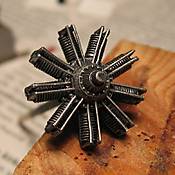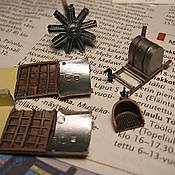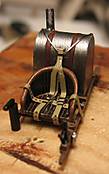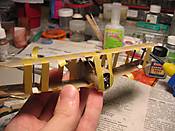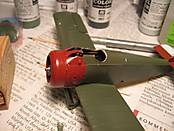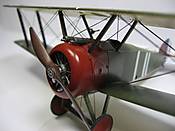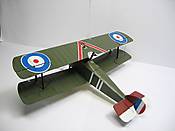1⁄35Sopwith Camel F.1 – My first plunge into
4
Comments
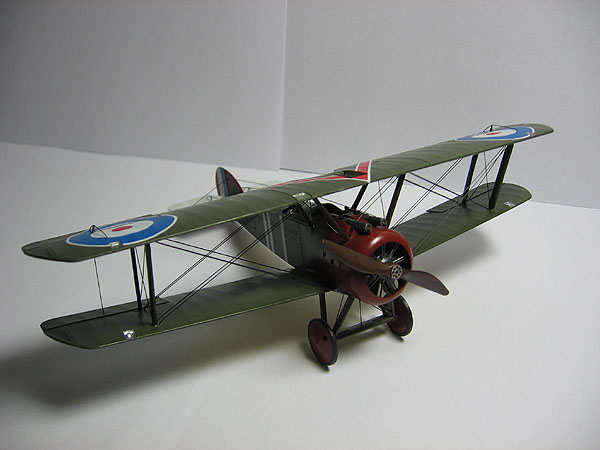
Construction
I started the build as the instructions suggested, with the engine, its mounting, and the cockpit. The engine came together nicely, but the push-rods are molded together with the two front parts of the engine. They were pretty fragile, and I broke off most of rods from the front part. Fortunately it was easy to replace the broken rods with copper wire (see picture 1).Next I tackled the instrument panel and mg mount. Dial faces came as decals. They snuggled down nicely with micro sol.
The cockpit interior was easily built. Just be careful with the wicker decals that go to the seat, especially with the one that goes to the inner curve. Pre-painted seatbelts came on the PE fret, I coated them with matt clear to protect them while handling (see pictures 2&3).
Then it was time to close up the fuselage. I had to widen the rearmost cockpit mounts with styrene strip. I didn't add the tailskid at this point, as it looked fragile.
Next came the lower wing, to which I glued the separate ailerons, cockpit floor and control stick. Then I attached the lower wing to the fuselage. To get the wing to sit properly, I had to cut the firewall mounts that were in the way. I just used clippers (the result doesn't have to be pretty), it's impossible to see the firewall in the finished model anyway. At this point the instructions tell you to attach the back parts of the machine guns before gluing on the upper fuselage. Don't do this! It's much easier to glue on the completed mg's, and you get the two parts aligned properly, too. I then assembled and painted the mg's. Take care to sand the mating surfaces flat so the mg's will be straight.
The vertical and horizontal stabilisers were also attached at this point. Again, I glued the control surfaces in place before attaching to the fuselage.
The instructions then tell you to attach the upper wing, which I didn't do yet. I assembled and glued on the landing gear, but left off the wheels for now. Here I made a mistake; I thought that the steps at the end of the landing gear legs are because of mold misalignment and sanded them away. Don't do that, they're actually connectors that fit to small holes in the fuselage bottom. I had to glue small bits of styrene to help in alignment.
Next came the top wing. I glued the fuselage struts to the upper, and outer struts to the lower wing. I fixed the wing in place with masking tape to get the struts aligned properly. (I recommend making attachment pins from metal wire for the outer struts, as the bonding area is small and weak and I eventually broke off three of the struts while working). Here I found one mistake in the instructions. The outer wing struts are numbered B19 (front) and B9 (back). They fit properly the other way round. Dry-fit before gluing (see picture 4).
Painting, decaling, rigging
Then it was time to start painting. The upper wing was painted and decaled separately. For the paint scheme, I chose the classic green overall with red engine cowling and front fuselage. The markings were for Capt. Roy Brown's plane. (The instruction state it was Sopwith Camel F.1 B7270, Capt. Roy Brown, No. 209 Sqn, Berfangles, France, April 1918).The model was first primed with Vallejo’s grey primer. Model Color paints from the same manufacturer were used for the other colors as well. The red cowling, wheel hubs, and horizontal stabiliser were painted with cavalry brown (no. 982). The green is dark green (no. 893). The instructions indicate to paint the fuselage around the cockpit and the landing gear with a 5:1 mix of dark green and wood brown, which I did. For the brown I used beige brown (no. 875). I don't think it's absolutely necessary, as the difference is hardly noticeable. For the linen parts, I used yellow ochre (no. 913). Masks are included in the kit, but I only used them for the wheels.
I coated the model with Johnson's floor wax (Future / Klear) prior to applying the decals. Speaking of the decals, they were great, as usual with Eduard. They snuggled right into the details with a little Micro Sol. Then I applied a couple of coats of a mix of floor wax and Tamiya flat agent, which produced a nice satin sheen. I left the cowling glossy, though.
Next came attaching the upper wing. I used two-part epoxy for this. I had to mix up a couple of batches of it before I got the wing and all the struts aligned and attached. Again, masking tape held the wing in place while the epoxy cured. Then it was time for rigging. I carefully re-opened any holes that had paint in them. I used black fishing line for all the wires, attached with superglue. After the glue cured, I trimmed the extras off and shaved off any extra glue on the upper and lower wing surfaces. After a little touch-up, I was almost done. I wasn't sure how to touch up the holes on the roundels. I tried to touch-up the white parts, but that looked awful, so I wiped it off. But I was able to touch-up the blue areas with Citadel's enchanted blue, as it matched the blue on the decals almost perfectly.
Finishing off
The propeller was first painted with Citadel's scorched brown, then dry-brushed with a lighter brown and then came a black wash (I used Lifecolor's "oil" wash). The wood grains were then done by dry-brushing with a really coarse plastic brush (actually, the first brush I ever got. It came with a Revell kit with two tins of paint. Those were the days...). After painting the boss, I gave the propeller a few coats of my floor wax/flat agent mix, and it ready for installing.Finally, I attached the tailskid, wheels, machine guns, and the propeller, and the model was finished.
Comments
Superb, I hope we get more from Eetu.
I must start a collection of WWI aircraft
Mal
SEP 25, 2005 - 12:08 AM
I'm already planning to do another feature. I'm currently building trumpeter's 1:72 wyvern and I think it would make a nice build article.
SEP 25, 2005 - 03:44 AM
Bravo Eetu!
Excellent article, this is the way to go... Looking forward for that Wyvern build!
Jean-Luc
SEP 25, 2005 - 05:25 AM
Copyright ©2021 by Eetu Tahvonen. Images also by copyright holder unless otherwise noted. The views and opinions expressed herein are solely the views and opinions of the authors and/or contributors to this Web site and do not necessarily represent the views and/or opinions of AeroScale, KitMaker Network, or Silver Star Enterrpises. Images also by copyright holder unless otherwise noted. Opinions expressed are those of the author(s) and not necessarily those of AeroScale. All rights reserved. Originally published on: 2005-09-25 00:00:00. Unique Reads: 12277




